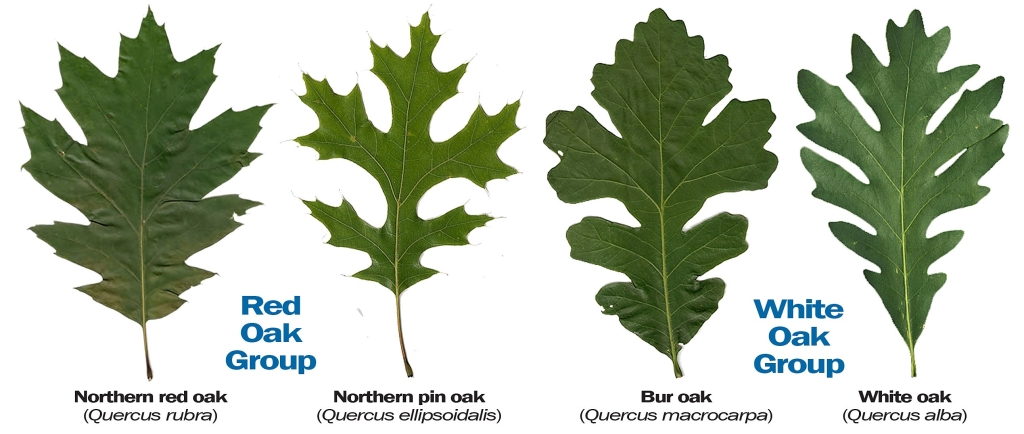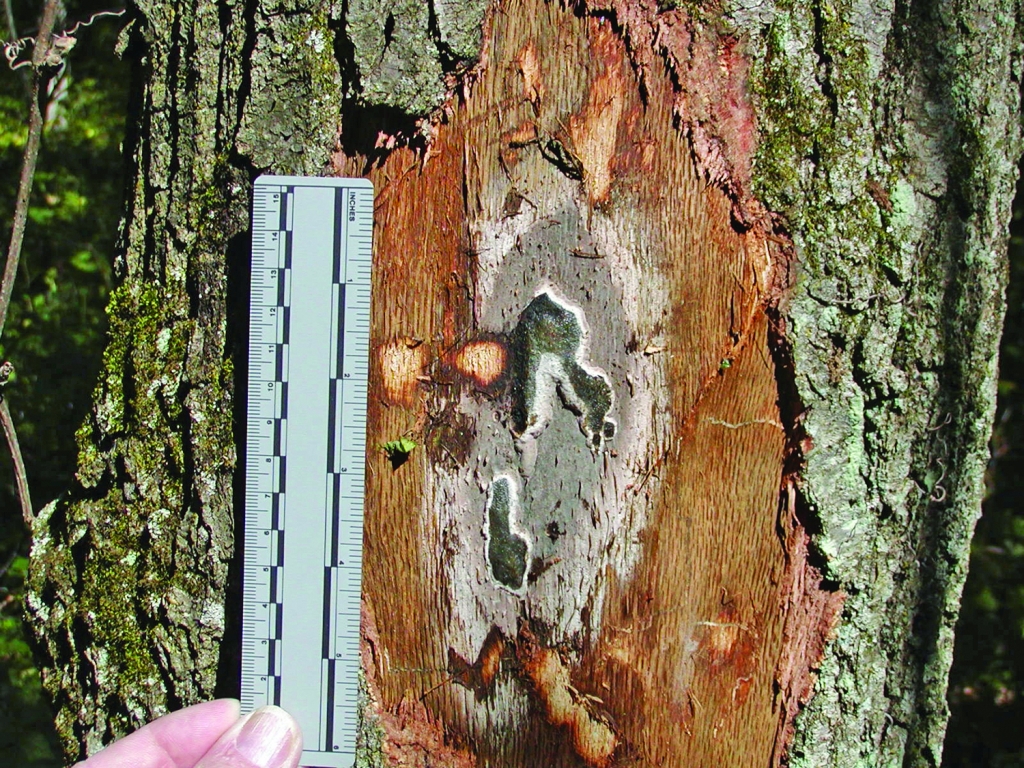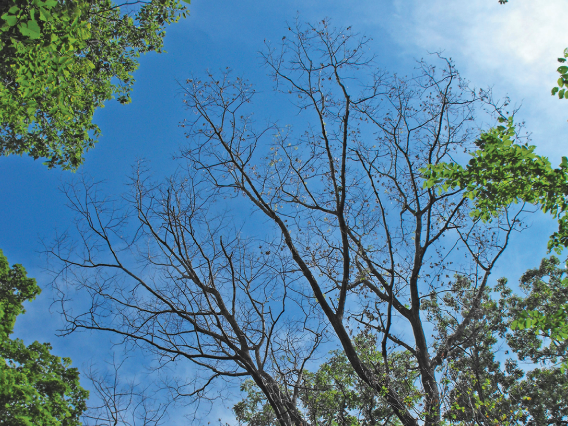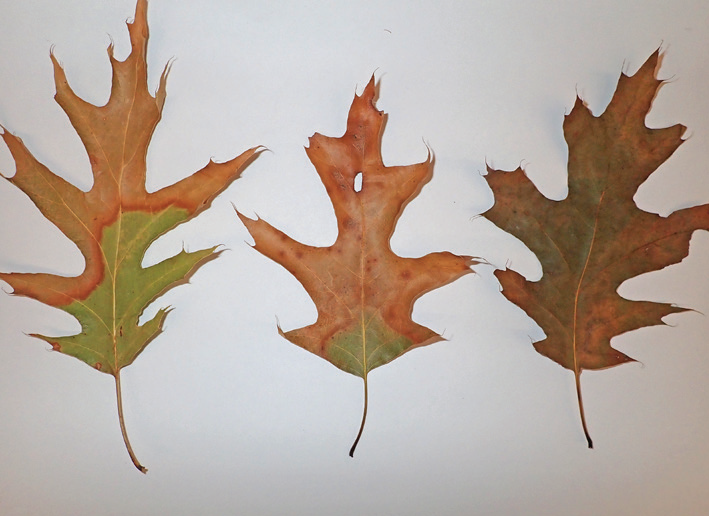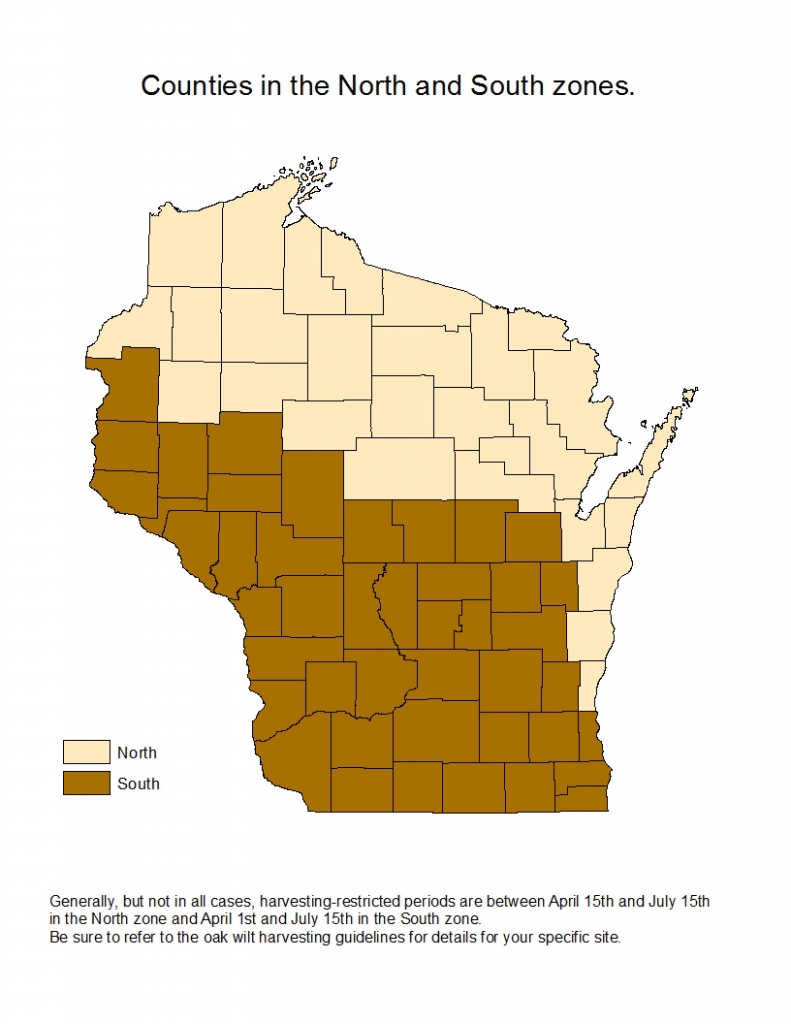Oak Wilt
Learn if your property is at risk, how to reduce the spread of oak wilt in a forested area, how to know if a tree has oak wilt and much more.
Distribution
Oak wilt is widespread in southern Wisconsin, but in much of northern Wisconsin it is still a new and uncommon disease.
The following map shows oak wilt detections in Wisconsin as of October 25, 2023.
Impact
Oak wilt kills thousands of trees each year in forests, woodlots and urban areas. Oak wilt can even attack and kill healthy trees. The disease is a particularly serious problem for species in the red oak group such as northern red, northern pin and black oaks. Once wilting symptoms are apparent on a red oak, the infected tree will lose most of its leaves and die within approximately one month. Among the white oak group, bur and swamp white oaks demonstrate moderate tolerance to the disease, living several years after symptoms first appear. White oaks experience even slower disease progression and may survive infection.
Dead oak trees can serve as excellent den trees for wildlife. Oaks do not decay as quickly as aspen, birch and red maple, so they will provide shelter for wildlife for many years. As oaks die, the site often becomes brushy for about 10 years. Warblers, grosbeaks, cuckoos, cardinals, grouse, rabbits, deer and shrews will be attracted to the brushy area. Brown creepers may nest under the bark falling off dead trees. Dead trees will also supply insects for birds, and large dead trees may provide perches for raptors.
Biology
Oak wilt is caused by the fungus, Bretziella fagacearum. The fungus grows through the infected tree’s water conducting system, causing the tree to wilt and die. Oak wilt is introduced to an area by sap-feeding beetles that carry oak wilt spores to fresh wounds. Spore-bearing fungal mats develop under the bark in the fall or spring following the death of the infected tree.
The sap-feeding beetles are attracted to the fungal mats and can transport oak wilt spores to fresh wounds or to recently cut oak stumps. Once in an area, the disease spreads to nearby oak trees through interconnected (grafted) root systems, creating an expanding pocket of dead oak trees.
Are you thinking of building on a wooded lot? Learn how to protect your trees from oak wilt [PDF]. For general information on oak wilt in Wisconsin's forests, consult this oak wilt fact sheet.
Identification
Leaves will wilt and drop from the upper canopy first. Symptoms progress down the tree rapidly. Infected leaves wilt rapidly and drop to the ground in summer. Wilting symptoms are observed from June through September, most commonly in July and August.
Unlike normal leaf fall, the leaves of infected trees drop to the ground when they are still partially green. The symptoms of oak wilt are similar to those of other pest, disease and abiotic issues. A symptomatic tree should be sampled and examined by a laboratory for proper diagnosis, especially if active management is being considered.
Find out if your tree has oak wilt
For urban trees:
- Contact a local urban forestry consultant/arborist
- Submit a sample to the University of Wisconsin-Madison Plant Disease Diagnostics Clinic [exit DNR] for an oak wilt lab test
For forest trees:
- Contact your local forester
- Contact your regional DNR forest health specialist
Prevention
In urban/residential areas
Once the disease exists in a stand, it is difficult to control. Prevention of this disease is the best approach. The greatest risk of oak wilt transmission occurs in the spring and early summer (April through July), when oak wilt spore-carrying beetles are abundant and fungal mats are fresh. This interface provides users localized information about the estimated emergence status of the two most important insects that transmit oak wilt in Wisconsin, based on a degree-day model.
If oak trees need to be pruned between April and July, spray or paint tree wound sealer immediately after the cut is made. This barrier will prevent the introduction of spores by sap-feeding beetles. Check with your municipality to find out if they have their own oak wilt ordinances that you should follow as well.
In forests
To help reduce risk, the DNR developed the oak harvesting guidelines [PDF] to reduce the introduction and spread of oak wilt. These recommend harvesting only during the non-restricted period if your stand is in a county that has oak wilt or is within 6 miles of a county with oak wilt. Harvesting restricted periods are dependent on your location in the state and are:
- North Zone: April 15 to July 15.
- South Zone: April 1 to July 15.
However, the guidelines’ Exceptions and Modifications allow for stand-level flexibilities. Please read the guidelines for more information. This interface provides users localized information about the estimated emergence status of the two most important insects that transmit oak wilt in Wisconsin, based on a degree-day model. If oak trees need to be pruned during the harvesting restricted periods, apply wound sealer immediately after the wound is made to prevent the introduction of spores by sap-feeding beetles.
Electrical Utilities
For oak pruning to clear electrical utility lines, refer to the Wisconsin Administrative Code PSC 113.0511 - Oak tree cutting and pruning.
Management
Although management to control the below-ground spread of oak wilt can be complicated and costly, active management can be successful. Controlling below-ground spread requires disrupting the movement of the fungus through root grafts from infected trees to healthy trees. Physical severing of the root system using a vibratory plow or a trencher has proven to be effective if plow lines are placed correctly. Recently, field trials have shown some promising results to contain the below-ground spread of oak wilt by using herbicides on, or by uprooting the entire root mass of, healthy oaks that border the infected pocket.
Trees that have died of oak wilt will harbor spores for approximately 1 year after death. Once root grafts have been disrupted, dead and live trees inside a pocket should be harvested to limit the spread of the disease by beetles. If you are interested in options for active management of oak wilt, please contact your local DNR forester or DNR forest health specialist.
Check out Wisconsin DNR's Oak Harvesting Guidelines to Reduce the Risk of Introduction and Spread of Oak Wilt [PDF] or the Wisconsin DNR's oak wilt management fact sheet [PDF] for more information.
Firewood
Moving infected firewood can spread oak wilt long distances to a previously disease-free area. Keep firewood local and consider covering it with 4 mil plastic until the bark is loose. Wood from dead trees with loose bark, and from apparently healthy trees with no wilting symptoms, does not pose a risk for the spread of oak wilt. Wisconsin has developed a number of requirements pertaining to the movement of firewood. Learn more about firewood restrictions.
Other issues
Both native and non-native oaks are susceptible to a range of insects, diseases and abiotic issues. Some examples include bur oak blight, anthracnose, leaf tatters, leaf and twig galls and two-lined chestnut borer. Review the following links to learn more about these other issues that may be impacting oak trees on your property.


